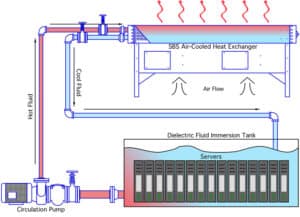A Cool Duo: Air Cooled Heat Exchanger and Immersion Cooling for Data Centers
October 4, 2023 by Peter Delone

In the fast-paced world of technology, data centers are the beating hearts that keep our digital lives running smoothly. Ensuring the efficient cooling of data center equipment is not just a luxury but a necessity. Enter the dynamic duo of an Air Cooled Heat Exchanger (ACHE) and Immersion Cooling. In this blog post, we’ll explore the benefits of combining these two cooling technologies to maintain optimal temperatures in data center applications.
Before we dive into the advantages of this innovative cooling approach, let’s understand the challenges faced by data center operators:
1. Heat Generation: High-density server racks and processing units generate substantial amounts of heat. Efficient cooling is essential to prevent overheating and maintain equipment reliability.
2. Energy Efficiency: Traditional air cooling systems used in data centers consume significant energy to maintain the desired temperature, contributing to high operational costs and environmental concerns.
3. Space Constraints: Data centers often operate in space-constrained environments. Implementing effective cooling solutions while optimizing the use of limited space can be challenging.
Now, let’s explore how the combination of an Air Cooled Heat Exchanger (ACHE) and Immersion Cooling addresses these challenges and offers a transformative solution for data center cooling:
1. Efficient Heat Dissipation: The ACHE efficiently transfers heat from the immersion cooling tanks to the surrounding air. This ensures that the high-density server racks remain at optimal operating temperatures, preventing overheating and equipment failures.
2. Energy Savings: The ACHE, when used in conjunction with immersion cooling, reduces the reliance on traditional air cooling systems. This leads to significant energy savings, lower operational costs, and a reduced carbon footprint.
3. Space Optimization: Immersion cooling systems are space-efficient and can be deployed within existing data center layouts. The ACHE’s compact design further optimizes space utilization, allowing for more computing power in the same footprint.
4. Reduced Maintenance: Immersion cooling eliminates the need for air filters, reducing maintenance requirements and associated downtime. The ACHE’s robust design minimizes maintenance hassles, ensuring continuous data center operation.
5. Environmental Responsibility: By reducing energy consumption and lowering the environmental impact of data center operations, the combination of ACHE and Immersion Cooling aligns with sustainability goals.
6. Enhanced Equipment Lifespan: Maintaining consistent and optimal operating temperatures with this cooling duo extends the lifespan of data center equipment, reducing replacement and upgrade costs.
7. Scalability: As data center operations grow, the ACHE and Immersion Cooling can scale easily to accommodate increased heat loads without significant infrastructure changes.
Conclusion
The fusion of an Air Cooled Heat Exchanger and Immersion Cooling presents an innovative and efficient solution to the cooling challenges faced by data centers. By efficiently dissipating heat, reducing energy consumption, optimizing space utilization, and minimizing maintenance requirements, this cooling duo ensures that data center operations remain reliable, cost-effective, and environmentally responsible. Embrace the power of efficient cooling with ACHE and Immersion Cooling, and take your data center operations to new heights of performance and sustainability.
